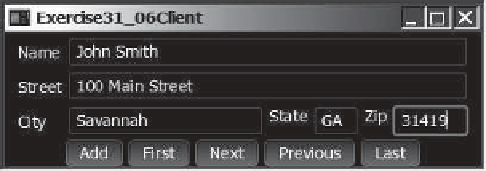Java Reference
In-Depth Information
receives the count from the server and display a message, such as You are visi-
tor number 11, as shown in Figure 31.19. Name the client Exercise31_04Client
and the server Exercise31_04Server.
F
IGURE
31.19
The client displays how many times the server has been accessed. The server stores the count.
31.5
(
Send loan information in an object
) Revise Exercise 31.1 for the client to
send a loan object that contains annual interest rate, number of years, and loan
amount and for the server to send the monthly payment and total payment.
Section 31.6
31.6
(
Display and add addresses
) Develop a client/server application to view and
add addresses, as shown in Figure 31.20.
F
IGURE
31.20
You can view and add an address.
Use the
StudentAddress
class defined in Listing 31.5 to hold the name,
street, city, state, and zip in an object.
■
The user can use the buttons
First
,
Next
,
Previous
, and
Last
to view an
address, and the
Add
button to add a new address.
■
Limit the concurrent connections to two clients.
■
Name the client Exercise31_06Client and the server Exercise31_6Server.
*31.7
(
Transfer last 100 numbers in an array
) Programming Exercise 22.12 retrieves
the last 100 prime numbers from a file
PrimeNumbers.dat
. Write a client
program that requests the server to send the last 100 prime numbers in an
array. Name the server program Exercise31_07Server and the client program
Exercise31_07Client. Assume that the numbers of the
long
type are stored in
PrimeNumbers.dat
in binary format.
*31.8
(
Transfer last 100 numbers in an ArrayList
) Programming Exercise 24.12
retrieves the last 100 prime numbers from a file
PrimeNumbers.dat
.
Write a
client program that requests the server to send the last 100 prime numbers in
an
ArrayList
. Name the server program Exercise31_08Server and the client
program Exercise31_08Client. Assume that the numbers of the
long
type are
stored in
PrimeNumbers.dat
in binary format.


















Search WWH ::

Custom Search